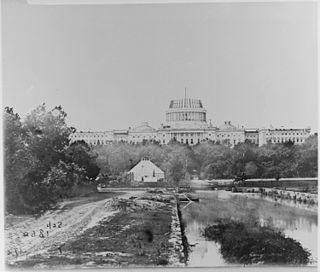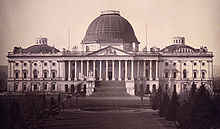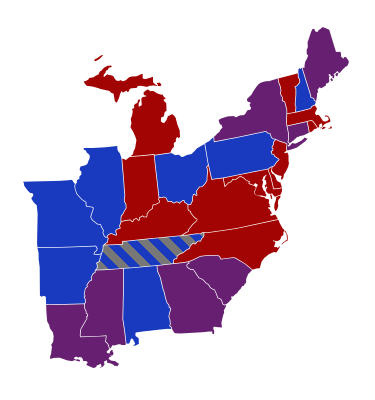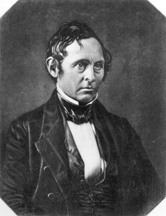
The 14th United States Congress was a meeting of the legislative branch of the United States federal government, consisting of the United States Senate and the United States House of Representatives. It met in the Old Brick Capitol in Washington, D.C. from March 4, 1815, to March 4, 1817, during the seventh and eighth years of James Madison's presidency. The apportionment of seats in the House of Representatives was based on the 1810 United States census. Both chambers had a Democratic-Republican majority.

The 15th United States Congress was a meeting of the legislative branch of the United States federal government, consisting of the United States Senate and the United States House of Representatives. It met in the Old Brick Capitol in Washington, D.C. from March 4, 1817, to March 4, 1819, during the first two years of James Monroe's presidency. The apportionment of seats in the House of Representatives was based on the 1810 United States census. Both chambers had a Democratic-Republican majority.

The 17th United States Congress was a meeting of the legislative branch of the United States federal government, consisting of the United States Senate and the United States House of Representatives. While its term was officially March 4, 1821, to March 4, 1823, during the fifth and sixth years of James Monroe's presidency, its first session began on December 3, 1821, ending on May 8, 1822, and its second session began on December 2, 1822, to March 3, 1823. The apportionment of seats in the House of Representatives was based on the 1810 United States census. Both chambers had a Democratic-Republican majority.

The 18th United States Congress was a meeting of the legislative branch of the United States federal government, consisting of the United States Senate and the United States House of Representatives. It met in Washington, D.C., from March 4, 1823, to March 4, 1825, during the seventh and eighth years of James Monroe's presidency. The apportionment of seats in the House of Representatives was based on the 1820 United States census. Both chambers had a Democratic-Republican majority.

The 20th United States Congress was a meeting of the legislative branch of the United States federal government, consisting of the United States Senate and the United States House of Representatives. It met in Washington, D.C. from March 4, 1827, to March 4, 1829, during the third and fourth years of John Quincy Adams's presidency. The apportionment of seats in the House of Representatives was based on the 1820 United States census. Both chambers had a Jacksonian majority.

The 22nd United States Congress was a meeting of the legislative branch of the United States federal government, consisting of the United States Senate and the United States House of Representatives. It met in Washington, D.C. from March 4, 1831, to March 4, 1833, during the third and fourth years of Andrew Jackson's presidency. The apportionment of seats in the House of Representatives was based on the 1820 United States census. Both chambers had a Jacksonian majority.

The 23rd United States Congress was a meeting of the legislative branch of the United States federal government, consisting of the United States Senate and the United States House of Representatives. It met in Washington, D.C. from March 4, 1833, to March 4, 1835, during the fifth and sixth years of Andrew Jackson's presidency. The apportionment of seats in the House of Representatives was based on the 1830 United States census. The Senate had an Anti-Jacksonian or National Republican majority, and the House had a Jacksonian or Democratic majority.

The 24th United States Congress was a meeting of the legislative branch of the United States federal government, consisting of the United States Senate and the United States House of Representatives. It met in Washington, D.C. from March 4, 1835, to March 4, 1837, during the seventh and eighth years of Andrew Jackson's presidency. The apportionment of seats in the House of Representatives was based on the 1830 United States census. Both chambers had a Jacksonian majority.

The 25th United States Congress was a meeting of the legislative branch of the United States federal government, consisting of the United States Senate and the United States House of Representatives. It met in Washington, D.C. from March 4, 1837, to March 4, 1839, during the first two years of Martin Van Buren's presidency.

The 26th United States Congress was a meeting of the legislative branch of the United States federal government, consisting of the United States Senate and the United States House of Representatives. It met in Washington, D.C., from March 4, 1839, to March 4, 1841, during the third and fourth years of Martin Van Buren's presidency. The apportionment of seats in the House of Representatives was based on the 1830 United States census. Both chambers had a Democratic majority.

The 29th United States Congress was a meeting of the legislative branch of the United States federal government, consisting of the United States Senate and the United States House of Representatives. It met in Washington, D.C. from March 4, 1845, to March 4, 1847, during the first two years of James Polk's presidency. The apportionment of seats in the House of Representatives was based on the 1840 United States census. Both chambers had a Democratic majority.

The 28th United States Congress was a meeting of the legislative branch of the United States federal government, consisting of the United States Senate and the United States House of Representatives. It met in Washington, D.C., from March 4, 1843, to March 4, 1845, during the third and fourth years of John Tyler's presidency. The apportionment of seats in this House of Representatives was based on the 1840 United States census. The Senate had a Whig majority, and the House had a Democratic majority.

The 30th United States Congress was a meeting of the legislative branch of the United States federal government, consisting of the United States Senate and the United States House of Representatives. It met in Washington, D.C. from March 4, 1847, to March 4, 1849, during the last two years of the administration of President James K. Polk. The apportionment of seats in the House of Representatives was based on the 1840 United States census. The Senate had a Democratic majority, and the House had a Whig majority. It was the only Congress in which Abraham Lincoln served.

Willie Person Mangum was an American politician and planter who served as U.S. Senator from the state of North Carolina between 1831 and 1836 and between 1840 and 1853. He was one of the founders and leading members of the Whig party, and was a candidate for president in 1836 as part of the unsuccessful Whig strategy to defeat Martin Van Buren by running four candidates with local appeal in different regions of the country.

The 32nd United States Congress was a meeting of the legislative branch of the United States federal government, consisting of the United States Senate and the United States House of Representatives. It met in Washington, D.C. from March 4, 1851, to March 4, 1853, during the last two years of Millard Fillmore's presidency. The apportionment of seats in the House of Representatives was based on the 1840 United States census. Both chambers had a Democratic majority.

The 35th United States Congress was a meeting of the legislative branch of the United States federal government, consisting of the United States Senate and the United States House of Representatives. It met in Washington, D.C. from March 4, 1857, to March 4, 1859, during the first two years of James Buchanan's presidency. The apportionment of seats in the House of Representatives was based on the 1850 United States census. Both chambers had a Democratic majority.

The 33rd United States Congress was a meeting of the legislative branch of the United States federal government, consisting of the United States Senate and the United States House of Representatives. It met in Washington, D.C. from March 4, 1853, to March 4, 1855, during the first two years of Franklin Pierce's presidency. During this session, the Kansas–Nebraska Act was passed, an act that soon led to the creation of the Republican Party. The apportionment of seats in the House of Representatives was based on the 1850 United States census. Both chambers had a Democratic majority.

The 45th United States Congress was a meeting of the legislative branch of the United States federal government, consisting of the United States Senate and the United States House of Representatives. It met in Washington, D.C. from March 4, 1877, to March 4, 1879, during the first two years of Rutherford Hayes's presidency. The apportionment of seats in the House of Representatives was based on the 1870 United States census. The Senate had a Republican majority, and the House had a Democratic majority.

The 58th United States Congress was a meeting of the legislative branch of the United States federal government, composed of the United States Senate and the United States House of Representatives. It met in Washington, DC, from March 4, 1903, to March 4, 1905, during the third and fourth years of Theodore Roosevelt's presidency. The apportionment of seats in the House of Representatives was based on the 1900 United States census. Both chambers had a Republican majority.
The 1842 United States elections occurred in the middle of President John Tyler's term, during the Second Party System. Tyler had become president on April 4, 1841, upon the death of his predecessor, William Henry Harrison. Elected as vice president on the Whig ticket with Harrison in 1840, Tyler was expelled from the party in September 1841. Members of the 28th United States Congress were chosen in this election. Florida joined the union during the 28th Congress. Whigs kept control of the Senate, but lost control of the House.














